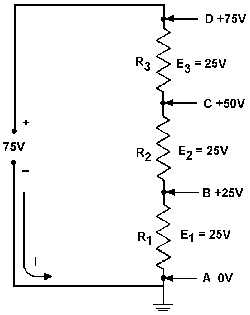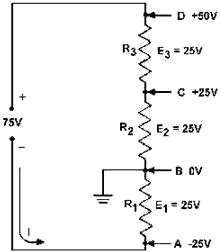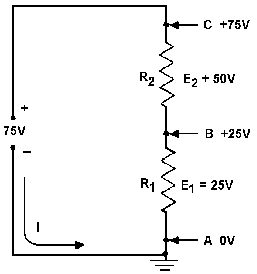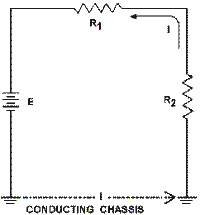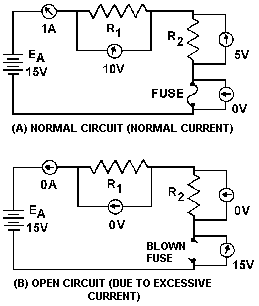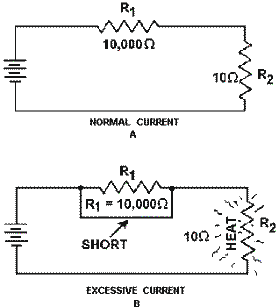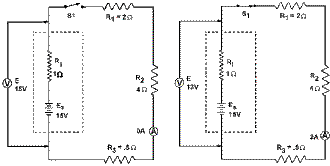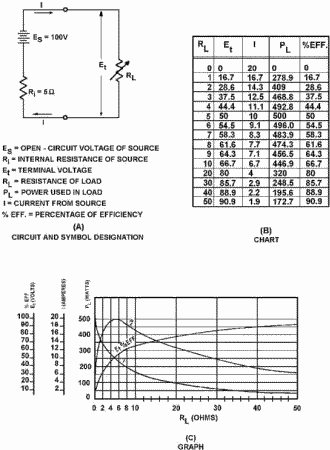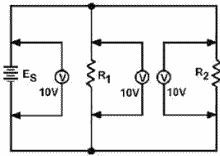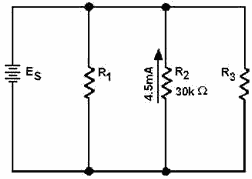Module 1 - Introduction to Matter, Energy, and Direct Current
|
||||||||||||||||||||||||||||||||||||||||||||||||||
|
Module 1 − Introduction to Matter, Energy, and Direct Current
Pages i, 1−1, 1−11, 1−21, 1−31, 1−41, 1−51, 1−61, 2−1, 2−11, 2−21, 3−1, 3−11, 3−21, 3−31, 3−41, 3−51, 3−61, 3−71, 3−81, 3−91, 3−101, 3−111, 3−121, Appendix I, II, III, IV, V, Index
Figure 3-28. - Reference points in a series circuit. When point B is used as the reference, as in figure 3-29, point D would be positive 50 volts in respect to the new reference point. The former reference point, A, is 25 volts negative in respect to point B.
Figure 3-29. - Determining potentials with respect to a reference point. 3-41 As in the previous circuit illustration, the reference point a circuit is always considered to be at zero potential. Since the earth (ground) is said to be at a zero potential, the term Ground is used to denote a common electrical point zero potential. In figure 3-30, point a is the zero reference, or ground, and the symbol for ground is shown connected to point A. Point C is 75 volts positive in respect to ground.
Figure 3-30. - use ground symbols. In most electrical equipment, the metal chassis is the common ground for the many electrical circuits. When each electrical circuit is completed, common points a circuit at zero potential are connected directly to the metal chassis, thereby eliminating a large amount connecting wire. The electrons pass through the metal chassis (a conductor) to reach other points the circuit. An example a chassis grounded circuit is illustrated in figure 3-31. 3-42
Figure 3-31. - Ground used as a conductor. Most voltage measurements used to check proper circuit operation in electrical equipment are taken in respect to ground. One meter lead is attached to a grounded point and the other meter lead is moved to various test points. Circuit measurement is explained in more detail in NEETS Module 3. OPEN Circuit A circuit is said to be OPEN when a break exists in a complete conducting pathway. Although an open occurs when a switch is used to deenergize a circuit, an open may also develop accidentally. To restore a circuit to proper operation, the open must be located, its cause determined, and repairs made. Sometimes an open can be located visually by a close inspection the circuit components. Defective components, such as burned out resistors, can usually be discovered by this method. Others, such as a break in wire covered by insulation or the melted element an enclosed fuse, are not visible to the eye. Under such conditions, the understanding the effect an open has on circuit conditions enables a technician to make use test equipment to locate the open component. In figure 3-32, the series circuit consists two resistors and a fuse. Notice the effects on circuit conditions when the fuse opens. 3-43
Figure 3-32. - Normal and open circuit conditions. (A) Normal current; (B) Excessive current. Current ceases to flow; therefore, there is no longer a voltage drop across the resistors. Each end the open conducting path becomes an extension the battery terminals and the voltage felt across the open is equal to the applied voltage (EA). An open circuit has INFINITE resistance. INFINITY represents a quantity so large it cannot be measured. The symbol for infinity is ∞. In an open circuit, RT = ∞. Short Circuit A short circuit is an accidental path low resistance which passes an abnormally high amount current. a short circuit exists whenever the resistance a circuit or the resistance a part a circuit drops in value to almost zero ohms. a short ten occurs as a result improper wiring or broken insulation. In figure 3-33, a short is caused by improper wiring. Note the effect on current flow. Since the resistor has in effect been replaced with a piece wire, practically all the current flows through the short and very little current flows through the resistor. Electrons flow through the short (a path almost zero resistance) and the remainder the circuit by passing through the 10-ohm resistor and the battery. The amount current flow increases greatly because its resistive path has decreased from 10,010 ohms to 10 ohms. Due to the excessive current flow the 10-ohm resistor becomes heated. As it attempts to dissipate this heat, the resistor will probably be destroyed. Figure 3-34 shows a pictorial wiring diagram, rather than a schematic diagram, to indicate how broken insulation might cause a short circuit. 3-44
Figure 3-33. - Normal and short circuit conditions.
Figure 3-34. - Short due to broken insulation. 3-45 SOURCE Resistance A meter connected across the terminals a good 1.5-volt battery reads about 1.5 volts. When the same battery is inserted into a complete circuit, the meter reading decreases to something less than 1.5 volts. This difference in terminal voltage is caused by the INTERNAL Resistance the battery (the opposition to current offered by the electrolyte in the battery). All sources electromotive force have some form internal resistance which causes a drop in terminal voltage as current flows through the source. This principle is illustrated in figure 3-35, where the internal resistance a battery is shown as R1. In the schematic, the internal resistance is indicated by an additional resistor in series with the battery. The battery, with its internal resistance, is enclosed within the dotted lines the schematic diagram. With the switch open, the voltage across the battery terminals reads 15 volts. When the switch is closed, current flow causes voltage drops around the circuit. The circuit current 2 amperes causes a voltage drop 2 volts across R1. The 1-ohm internal battery resistance thereby drops the battery terminal voltage to 13 volts. Internal resistance cannot be measured directly with a meter. An attempt to do this would damage the meter. Figure 3-35. - Effect of internal resistance. The effect the source resistance on the power output a dc source may be shown by an analysis the circuit in figure 3-36. When the variable load resistor (RL) is set at the zero-ohm position (equivalent to a short circuit), current (I) is calculated using the following formula:
3-46 This is the maximum current that may be drawn from the source. The terminal voltage across the short circuit is zero volts and all the voltage is across the resistance within the source. Figure 3-36. - Effect source resistance on power output. 3-47 If the load resistance (RL) were increased (the internal resistance remaining the same), the current drawn from the source would decrease. Consequently, the voltage drop across the internal resistance would decrease. At the same time, the terminal voltage applied across the load would increase and approach a maximum as the current approaches zero amps. Power Transfer and Efficiency Maximum power is transferred from the source to the load when the resistance the load is equal to the internal resistance the source. This theory is illustrated in the table and the graph figure 3-36. When the load resistance is 5 ohms, matching the source resistance, the maximum power 500 watts is developed in the load. The efficiency power transfer (ratio output power to input power) from the source to the load increases as the load resistance is increased. The efficiency approaches 100 percent as the load resistance approaches a relatively large value compared with that the source, since less power is lost in the source. The efficiency power transfer is only 50 percent at the maximum power transfer point (when the load resistance equals the internal resistance the source). The efficiency power transfer approaches zero efficiency when the load resistance is relatively small compared with the internal resistance the source. This is also shown on the chart figure 3-36. The problem a desire for both high efficiency and maximum power transfer is resolved by a compromise between maximum power transfer and high efficiency. Where the amounts power involved are large and the efficiency is important, the load resistance is made large relative to the source resistance so that the losses are kept small. In this case, the efficiency is high. Where the problem matching a source to a load is important, as in communications circuits, a strong signal may be more important than a high percentage efficiency. In such cases, the efficiency power transfer should be only about 50 percent; however, the power transfer would be the maximum which the source is capable supplying. You should now understand the basic concepts series circuits. The principles which have been presented are lasting importance. Once equipped with a firm understanding series circuits, you hold the key to an understanding the parallel circuits to be presented next. Q25. a circuit has a source voltage 100 volts and two 50-ohm resistors connected in series. If the reference point for this circuit is placed between the two resistors, what would be the voltage at the reference point? Q26. If the reference point in question 25 were connected to ground, what would be the voltage level the reference point? Q27. What is an open circuit? Q28. What is a short circuit? Q29. Why will a meter indicate more voltage at the battery terminal when the battery is out a circuit than when the battery is in a circuit? Q30. What condition gives maximum power transfer from the source to the load? Q31. What is the efficiency power transfer in question 30? Q32. a circuit has a source voltage 25 volts. The source resistance is 1 ohm and the load resistance is 49 ohms. What is the efficiency power transfer? 3-48 PARALLEL DC Circuits The discussion electrical circuits presented up to this point has been concerned with series circuits in which there is only one path for current. There is another basic type circuit known as the PARALLEL Circuit with which you must become familiar. Where the series circuit has only one path for current, the parallel circuit has more than one path for current. Ohm's law and Kirchhoff's law apply to all electrical circuits, but the characteristics a parallel dc circuit are different than those a series dc circuit. PARALLEL Circuit Characteristics A PARALLEL Circuit is defined as one having more than one current path connected to a common voltage source. Parallel circuits, therefore, must contain two or more resistances which are not connected in series. An example a basic parallel circuit is shown in figure 3-37.
Figure 3-37. - Example a basic parallel circuit. Start at the voltage source (Es) and trace counterclockwise around the circuit. Two complete and separate paths can be identified in which current can flow. One path is traced from the source, through resistance R1, and back to the source. The other path is from the source, through resistance R2, and back to the source. Voltage in a Parallel Circuit You have seen that the source voltage in a series circuit divides proportionately across each resistor in the circuit. IN a PARALLEL Circuit, The SAME Voltage Is PRESENT IN EACH BRANCH. (A branch is a section a circuit that has a complete path for current.) In figure 3-37 this voltage is equal to the applied voltage (Es). This can be expressed in equation form as: ES = ER1 = ER2 Voltage measurements taken across the resistors a parallel circuit, as illustrated by figure 3-38 verify this equation. Each meter indicates the same amount voltage. Notice that the voltage across each resistor is the same as the applied voltage. 3-49
Figure 3-38. - Voltage comparison in a parallel circuit. Example: Assume that the current through a resistor a parallel circuit is known to be 4.5 milliamperes (4.5 mA) and the value the resistor is 30,000 ohms (30 k ). Determine the source voltage. The circuit is shown in figure 3-39. Given:
Solution:
Figure 3-39. - Example problem parallel circuit. 3-50
|
||||||||||||||||||||||||||||||||||||||||||||||||||
